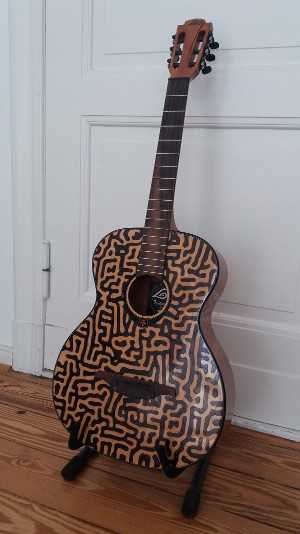I decided to put this project on hold, even if it's a bit buggy and not as good as I want. It works decently, I already learned a lot along the way, and I want to move on to something else, so this is a good time to consider it somewhat done. And I'm not selling it or anything so you don't have a right to complain :p
Remaining issues
So far all the image parameters (e.g. its size or the number of patterns) are defined as constants. So all the arrays (e.g. the 2D array that stores the image) are statically allocated. But I wanted to be able to call the program from a script and pass the parameters via the command line or via a configuration file. In this case, the parameters wouldn't be know at compilation time, and all the arrays that depend on them would have to be allocated dynamically.
I tried to implement this and there are two problems:
- It makes the program less clear and a lot less safe, what with the malloc's and free's everywhere. It's totally doable but I want to focus on getting the principles of multiscale Turing patterns right, not spend more time dealing with pointers to pointers to pointers.
- For some of the arrays, it's easy to switch to dynamic allocation. But for the image, it's more complicated. The image goes through several functions (blurring, applying the symmetries, normalizing...) that all have to be refactored to take pointers instead of 2D arrays. Again, it's no big deal in itself but my design makes it hard to change one function at a time and test it. I have to refactor the whole chain in one go. I tried to do that and I tried a couple of more subtle approaches, but it didn't work. I think my software design is to blame on that one.
Concretely, the problems that remain are the following:
- Only square images can be generated (see last log). I know that the problem comes from the blurring function but I wasn't able to correct it. The symmetry functions are also written for square images because I was lazy.
- The symmetry orders different than 2 or 4 (i.e. all the complicated ones) kind of work but with artifacts. I have no clue where that comes from.
- On some computers, with some parameters (picture too large?), the program crashes with a segfault.
What I learned
I made quite a lot of design mistakes at the beginning, and I realized the consequences when it was too late. I see that as a success because next time, I'll be more careful in the design phase. Incidentally, I just started reading "Code Complete" by Steve McConnell and he describes software design as a wicked problem, i.e. a problem that you have to solve once, mess up, and learn from your errors to solve it right the second time. That resonates with my experience here. Specifically, the mistakes I made:
- The functions that make the actual pattern generation are too dependent on one another. It's hard to modify one without having to change the others as well.
- I should have written unit tests for the important modules from the beginning.
- Related to the last point, from the beginning I tested all my functions with square images of sizes between 100x100 and 800x800 pixels. If I hadn't restricted myself to square images, I would have quickly seen that the blurring wasn't correct, when it was easier to debug. And if I had tried to generate larger images, I would have realized that it caused segfaults. So, I should have tested more liberally and not only special cases.
I also learned about Turing patterns, obviously, as well as doxygen and makefile. And I had to think a lot about pointers, which is always good.
Like I said earlier, I want to move on even if the source is still buggy. On the other hand, I'm not going to let something half-baked run around on the interwebz without ever correcting it -- I have a reputation to maintain. (No? I don't? Damn.) I'm definitely going to use what I learned here in another project featuring Turing patterns. Something über-fancy. In the meantime, I generated a cool single-scale pattern to decorate my guitar, so I'll leave you with that.

 xD
xD
Discussions
Become a Hackaday.io Member
Create an account to leave a comment. Already have an account? Log In.